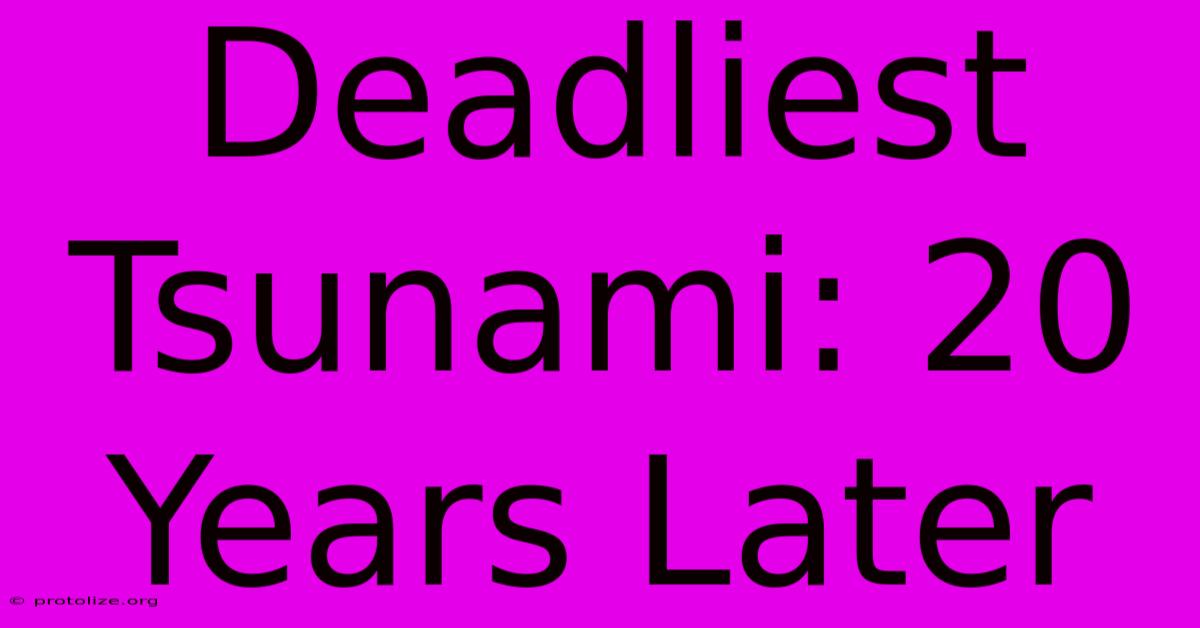Deadliest Tsunami: 20 Years Later

Discover more detailed and exciting information on our website. Click the link below to start your adventure: Visit Best Website mr.cleine.com. Don't miss out!
Table of Contents
Deadliest Tsunami: 20 Years Later – Reflecting on the 2004 Indian Ocean Earthquake and Tsunami
Twenty years have passed since the devastating Indian Ocean earthquake and tsunami of December 26, 2004, a catastrophic event that etched itself into the collective memory of the world. This wasn't just another natural disaster; it was a stark reminder of the immense power of nature and the vulnerability of coastal communities. The scale of the tragedy, the sheer loss of life, and the lasting impact continue to resonate today. This article reflects on the 2004 tsunami, examining its causes, consequences, and the lessons learned in the aftermath.
The Earthquake and its Devastating Ripple Effect
The 2004 Indian Ocean tsunami was triggered by a massive undersea megathrust earthquake measuring 9.1–9.3 on the moment magnitude scale. The epicenter was located off the west coast of Sumatra, Indonesia. This earthquake, one of the strongest ever recorded, caused the seafloor to rupture, displacing a colossal volume of water. This displacement generated a series of devastating tsunami waves that radiated outwards, impacting coastal areas across the Indian Ocean.
The Unfolding Disaster: A Wave of Destruction
The tsunami's impact was catastrophic. Coastal communities in Indonesia, Sri Lanka, India, Thailand, and many other countries were completely overwhelmed by walls of water up to 30 meters (100 feet) high. The speed and force of the waves left little time for evacuation, resulting in unimaginable destruction. Millions of people were affected, with homes, businesses, and infrastructure obliterated.
The Toll: Human Cost and Environmental Impact
The 2004 Indian Ocean tsunami resulted in an estimated 227,898 deaths across fourteen countries. This staggering number underscores the devastating impact of this natural disaster. Beyond the immediate loss of life, the tsunami caused widespread displacement, disease outbreaks, and long-term psychological trauma for survivors.
The environmental impact was equally significant. Mangrove forests, which act as natural barriers against tsunamis, were destroyed, leaving coastal communities more vulnerable in the future. Saltwater intrusion into freshwater sources contaminated drinking water and affected agriculture. Marine ecosystems were severely disrupted, impacting biodiversity and fishing communities.
Lessons Learned and Long-Term Recovery
The 2004 tsunami prompted a global reassessment of tsunami preparedness and response. Significant advancements have been made in early warning systems, including the development of advanced seismic monitoring networks and improved communication technologies. International cooperation has also strengthened, facilitating the sharing of information and resources to improve disaster preparedness and response efforts.
However, recovery efforts continue to this day. Many communities still struggle to rebuild their lives and livelihoods. The long-term psychological impacts of the tsunami persist, requiring ongoing support and care for survivors.
Strengthening Resilience: Preparing for the Future
The 2004 tsunami serves as a crucial reminder of the importance of investing in disaster preparedness. This includes:
- Improving early warning systems: Ensuring that accurate and timely warnings reach vulnerable communities.
- Strengthening infrastructure: Building resilient infrastructure capable of withstanding the forces of a tsunami.
- Educating communities: Providing training and education on tsunami safety measures.
- Protecting coastal ecosystems: Preserving and restoring natural barriers like mangrove forests.
- Promoting international cooperation: Strengthening collaborative efforts to improve global preparedness.
Remembering the Victims and Honoring Resilience
Twenty years after the 2004 Indian Ocean tsunami, it's vital to remember the victims and honor the resilience of those who survived. The tragedy serves as a stark reminder of the power of nature and the importance of investing in preparedness and mitigation efforts to minimize the impact of future disasters. The memory of this event should continue to motivate and guide our collective efforts to build a more resilient and safer world. Remembering the past is crucial to safeguarding the future.

Thank you for visiting our website wich cover about Deadliest Tsunami: 20 Years Later. We hope the information provided has been useful to you. Feel free to contact us if you have any questions or need further assistance. See you next time and dont miss to bookmark.
Featured Posts
-
I M A Celebrity 2024 Final Winner
Dec 09, 2024
-
Crm Companies Uk
Dec 09, 2024
-
Baker To Mc Millan Td Highlights
Dec 09, 2024
-
Landos 2024 Abu Dhabi Gp Qualifying
Dec 09, 2024
-
Five Months Later Ashworth Leaves United
Dec 09, 2024
